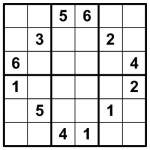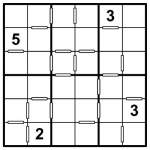Consecutive Sudoku

Standard Sudoku 6×6 puzzle
Consecutive Sudoku 6×6 puzzle
A Sudoku variant that I have always wanted to create, but somehow have just not quite ever got round to actually doing, is Consecutive Sudoku.
In Consecutive Sudoku, hollow bars between squares indicate that those two squares contain consecutive values – that is, each square is either one higher or one lower in value than the other. So if a square contains ‘3′ and there is a hollow bar between it and another square then that other square must contain either ‘2′ or ‘4′ – this is the consecutive constraint.
What makes it even more interesting is that the converse also applies – if there is not a hollow bar then the neighbouring squares are not consecutive. Therefore if a square contains ‘3′ then any neighbouring square without a hollow bar between them cannot contain either ‘2′ or ‘4′.
It might sound slightly complicated, but in fact the real beauty of this Sudoku variant is that it is actually beautifully simple when you come down to actually trying it. And what’s more, puzzles turn out to be considerably easier than you might imagine – the consecutive constraint is simple enough to trace and follow that it really helps you solve the puzzle, rather than being a complex relationship that just adds to the solving difficulty!
You also get the chance to use some new logic – it’s a very little bit like Futoshiki or Inequality Sudoku, but with (to me) a cleaner, more elegant solving path.
I’ve made an example puzzle. It’s 6×6 because it makes it easier to follow the rules if you’re new to the type – I’ll post some much larger versions soon, I promise!
Attached to this post are two puzzles, each leading to the same solution. The first is a (rather attractive circular) regular 6×6 Sudoku, which will give you the solution pretty easily if you need some help. The other is the consecutive version of the puzzle. As you can see, it has far less givens – just 4! But this is all that is needed. It shouldn’t take more than a few minutes to solve, I promise.
Standard Sudoku rules apply – place 1 to 6 into each row, column and 2×3 bold-lined box.
Good luck!
PS Just in case it isn’t obvious, when you click on the puzzle graphics they will open and load into a PDF viewer such as Adobe Acrobat (if you don’t have it click here to get it).
PPS And if you want to comment – e.g. say if you like this sort of puzzle and want to see more, or comment on how long it took you to solve it/how easy it was, then click on ‘No comments’ at the top of this post, or just click on the post title itself to open it in a new window with comments and comment box included.
Comments are closed.

about 16 years ago
This is great. An amazing twist to make it more interesting and another dimension to keep an eye on
about 16 years ago
I like this idea.
Not wanting to take away from your endeavors, but there is a website that has a standard sudoku size puzzle dealing with consecutive numbers you might check out if you haven’t already.
http://www.str8ts.com